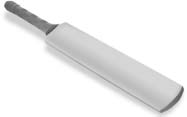
Grace would have donned a pair of climate-control boots – provided the price was right
The cricketer’s kit bag, or the ‘coffin’ as it’s euphemistically known in the trade, contains all the essentials – trousers, shirt, boots, pads, gloves and cap.
In essence it’s changed little over the last 100-odd years, save for the invention of polyester shirts and boots that come with ‘Climate Control’ features. ‘Piffle!’ as W.G. Grace might have exclaimed. Then again, he would probably have donned a pair of climate-control boots, complete with ‘Thermo Plastic Heel Counter’ and ‘Ultra Lightweight “Nickel Plated” Spikes’ – provided the price was right. Grace was never one to turn down an opportunity to make a quick buck and, given the chance, he would have put sponsors’ cash before sartorial elegance.
As it is, he had to make do with what was on offer, so we thought it only fair we let the good doctor describe for himself the contents of the cricketer’s kit bag. He was writing at the end of 1887, in an essay published in Cricket by A.G. Steel and R.H. Lyttleton, but his words ring true today.
He began his essay in characteristically forthright fashion, declaring: ‘I propose to say something about everything that is needful in the outfit of a cricketer, beginning with his personal clothing.’
Shirts: ‘It was no unusual sight ten or twenty years ago to find an eleven or country twenty-two dressed in all the colours of the rainbow. White is now usually worn, and it certainly looks better and cooler than any other colour.’
Trousers: ‘Be sure to try on every new pair of trousers when sent home from the tailor’s, or you may find out when too late to rectify the mistake that they are either too small or too large, and are completely useless. A revelation of this kind when you arrive on the cricket field and are getting ready to go in is destructive alike to high scoring and sweetness of temper.’
Caps: ‘I think indispensable and preferable to any kind of hats, unless in very hot weather under a broiling sun, when some protection to the neck and back of the head is necessary. 1887 was one of the hottest seasons I ever played through, but only once did I change my cap for a hat with a large brim.’
Sweaters: ‘Jackets and jerseys, or “sweaters”, as they are commonly called, have their place in the outfit of a cricketer… a jersey or sweater is preferable; it fits closer to the body, is much pleasanter, and in the field on a very cold day it helps to keep you warm…’
Socks: ‘They are better made plain, not ribbed, and in natural colours they are more comfortable and do not mark the feet.’

Grace would have donned a pair of climate-control boots – provided the price was right
Boots: ‘Have them made of brown or white leather. It is rather difficult to say what is the best thickness for the sole… I always wear thick soled boots with low flat heels; by having the heels low and flat you are not nearly so likely to sprain or twist your ankle as you would be with high and narrow ones. To prevent slipping it is necessary to wear spikes or nails in your boots or shoes. Be careful what sort of spikes or nails you use; I prefer short spikes, which are made in different sizes and can be screwed into the boots in a very short time… I should advise all cricketers who play often to have two pairs of boots, one with short spikes or nails which will hold and prevent slipping on a hard dry ground, and the other with longer spikes for a soft, wet spongy ground.’
Pads: ‘When choosing pads see that they are exactly your size and fit well, for large, heavy and uncomfortable pads will do as much to tire you out in a long innings as hard hitting.’
Gloves: ‘When purchasing gloves… see that the rubber on the fingers of the right-hand glove comes down slightly over the tops of the fingers, and on the side of the thumb instead of the back.’
And finally W.G. had this to say about the cricketer’s kit bag:
One made of good leather is preferable to any other sort. Mind you have it large enough to hold everything you can possible require. Have a strong lock and key for it, and straps as well. Have your name inscribed in the brass round the lock, and your initials painted in plain bold letters on the side. In the hurry of hand-shaking and bustle to catch a train the wrong bag has been often taken for want of this simple precaution.
No need for Grace to paint his name on the side of his kit bag; the sight of the initials W.G would have been enough to strike the fear of God into any absent-minded player.